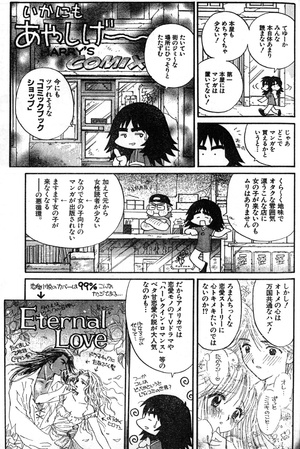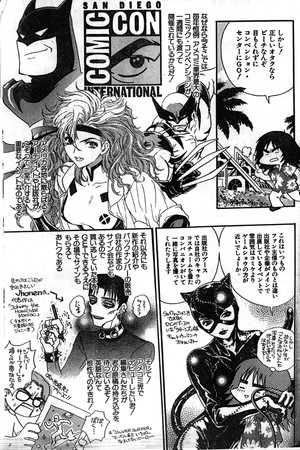Jason Thompson's House of 1000 Manga - Dame Dame Saito Nikki
by Jason Thompson,
Episode LVI: Dame Dame Saito Nikki

You're going to hate me for this. Today I'm writing about one of the most obscure manga I know of, a manga that isn't available in English in any form, even though it was listed in my book Manga: The Complete Guide. (Publishing deadlines are months and months in advance, and there had been discussion of an English-language release back in 2006. Like Nymphet, Chibimono and Neconoclasm, other nonexistent titles listed in Manga: The Complete Guide, I thought it was coming out.)
Tomoyuki Saito's Dame Dame Saito Nikki ("Saito's No-Good Diary") is a comedy manga that ran in Dengeki Daioh magazine from 2000 to 2001. It's not a typical four-panel gag manga, or a story manga, or anything like that, though; it's a semi-autobiographical manga, a series of four-page "manga essays" on the author's experiences living among manga fans in the strangest place on Earth: America.
Who wrote this strange manga? A quick Google Japan search turns up the fact that Tomoyuki Saito is an active dojinshi creator, and has also done artwork for other projects, such as Gainax's 2000 CD-ROM Animal Magnetism, an eroge featuring a variety of mildly furry animal-themed girls. According to information released when the series was first announced, Tomoyuki Saito is a Japanese artist who lives in America and has worked extensively as a translator/letterer for the manga localization company Studio Proteus. From the late '80s to this very day, Saito has worked on a ton of manga licensed by Studio Proteus and published by Dark Horse and other publishers; her recent work includes, among other titles, Blade of the Immortal. Saito also lives in San Francisco, where she is surrounded by manga culture, not to mention all the other SF coolness and weird stuff. (And I don't just mean that Viz is located there.)
In short, Saito is in the perfect spot to understand comics fandom, manga fandom, and American culture, and also she's got the authentic, finely-honed skills of a forged-in-the-fires-of-Japan mangaka. (Not that I'm dissing OEL artists, who get an undeservedly bad rap in manga fandom; Svetlana Chmakova is as good as any Japanese artist, and I bet Felipe Smith or Takeshi Miyazawa could do badass books about their experiences working as mangaka in Japan, if they weren't already busy drawing stuff.) All this probably made Dame Dame Saito Nikki an interesting curiosity for Japanese Dengeki Daioh readers ('cause I mean, everybody wants to know about life in America? We're still a cool country, right? Right…?), and an even more interesting curiosity for American manga fans. I love seeing a foreign perspective on America, the flaws and the good points, and Dame Dame Saito Nikki delivers. Far from the typical US-exoticizing manga full of big-nosed, freckled, blonde-haired Americans (although I love those too; speaking on behalf of all Americans, please feel free to exoticize us), it shows me an America I actually recognize: the America of anime conventions, cosplay skits and rundown comic book shops.

Tomoyuki Saito is a fun and irreverent guide. In the first chapter, she introduces herself as the creator of Animal Magnetism, and goes on to talk about how she loves pretty girls. Actually, it's a bit hard to tell from the comic alone whether Saito is male or female, but she mentions her gender somewhere, and there's a tenderness to all of Saito's bishojo artwork, even when she's ogling women's boobs together with some equally appreciative male mangaka or talking about the joy of fangirls with none other than Adam Warren, creator of Empowered. Dame Dame Saito Nikki never gets too deep into Saito's life, but we soon figure out that she'd probably be a fun person to go drinking with.
Dame Dame Saito Nikki is basically divided into two types of strips: the 'otaku and fandom' ones and the 'America in general' ones. In the manga fandom strips, Saito talks about her work in the manga industry and how manga is localized. Since Dame Dame Saito Nikki came out ten years ago, of course, what was once up-to-date has become early 2000s history: Saito talks about the process of 'flipping' manga (so big-nosed, freckled, blonde Americans can read it) and relettering it into English with analog methods, and then explains how manga is chopped up into 32-page comics which sell for 300 yen. ("32 pages for 300 yen…! That's expensive…!" says Saito's shocked companion.) She talks about VIZ's Pulp magazine, Dark Horse's Super Manga Blast, Adam Warren's Dirty Pair comics, and even about one of the greatest blessings Studio Proteus ever brought to the American manga market: the Studio Proteus/Eros Mangerotica editions of porno manga are 120% uncensored, since the original artists went back and redrew the genitalia that were censored in the Japanese editions. What about shojo manga? Well, this being 2000, hardly any shojo manga had been translated yet. She criticizes the typical American comic book store, those "dark, gloomy shops shouting of fanboy." ("Not many girls reading comics to begin with… so girls' comics don't get published… so girls stay away even more, and so…vicious circle!") But in other strips, Saito and Adam Warren seem to sense that they're on the crest of a generational wave, when millions of Sailor Moon-loving fangirls are about to pour on the American market demanding their floating flowers and sparkly screentone. Another chapter is dedicated to Americans who cosplay, and another glorious chapter is dedicated to Saito's trip to San Diego Comic-Con, where she meets Mike Mignola and Jhonen Vasquez, sees the Masquerade, and pigs out on honey walnut shrimp at the San Diego Hooters.

But another, more timeless part of the manga is Saito's introductions to non-otaku life in America. She particularly talks a lot about American holidays, which may have the same names but be very different from the way those holidays are celebrated in Japan. After all, in Japan girls give guys chocolates on Valentine's Day, but in America, it's a day for sexy lingerie and flowers! And Christmas isn't a romantic holiday like in Japan, it's a family holiday, where Americans eat turkey and fruitcake (or don't) and little girls leave milk and cookies under the tree for Santa. The Halloween strip talks about trick-or-treating and the typical costumes Americans wear, then segues into the very specific insanity of San Francisco's infamous Halloween party in the Castro, back before it got shut down by the cops due to excessive crowds and general mayhem. (Ahh, those days…) Saito also devotes a chapter to another great American obsession: losing weight. Years before Morgan Spurlock's film Super Size Me, she writes about Americans' obesity problem, the massive food portions, and the corresponding obsession with dieting and weight-loss products. As in every chapter of Dame Dame Saito Nikki, there's some fanservice shots of girls in sports bras, but there's also some drawings of unhealthily obese Americans in Elvis costumes to go along with them. But mostly, Saito is here to praise America, not criticize it. She even devotes an entire chapter to the Powerpuff Girls.
Dame Dame Saito Nikki is a wonderfully drawn, funny comic; if you like books like Aimee Major-Steinberger's Japan Ai: A Tall Girl's Adventures in Japan, or the anthology Japan as Viewed by 17 Creators published by Fanfare/Ponent-Mon, or any stories of crosscultural fandom mixups, you'll love this manga. But tragically, it's almost impossible to get hold of, even in Japan. I have my own copies because I photocopied them from the pages of Dengeki Daioh as it was coming out, but sadly, the series was canceled abruptly and never even released in tankobon. I often wonder what cultural stuff Saito would have written about if the manga had been allowed to go on a little longer. (She hadn't even run out of holidays yet!) If you've got a sense of humor and access to back issues of Dengeki Daioh—there are stores in Tokyo that sell them—check out this gem. As for everyone else, enjoy the pictures. You may lynch me now, although if you do, I'll never get the chance to write about Viz's planned release of Haoh Airen.
Jason Thompson is the author of Manga: The Complete Guide and King of RPGs, as well as manga editor for Otaku USA magazine.
Banner designed by Lanny Liu.
discuss this in the forum (33 posts) |


